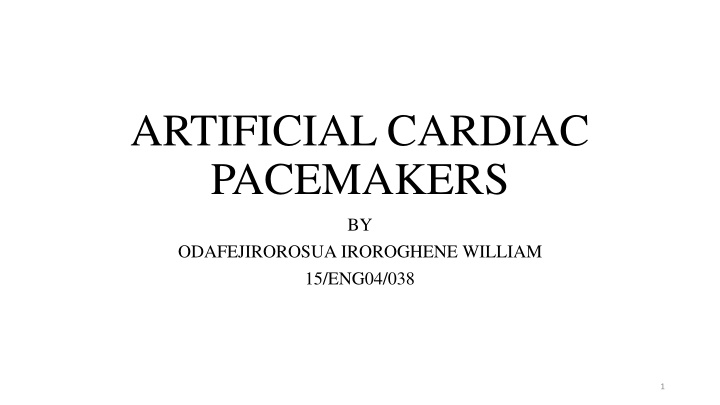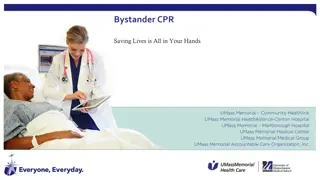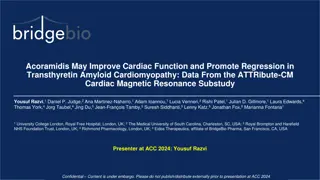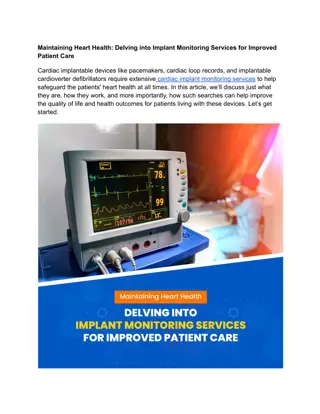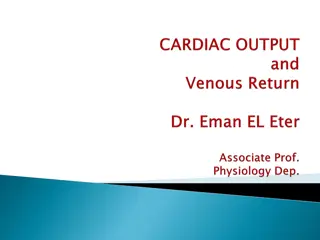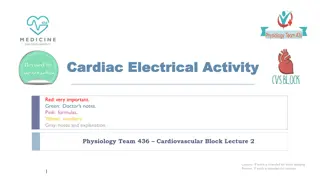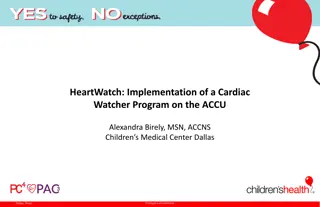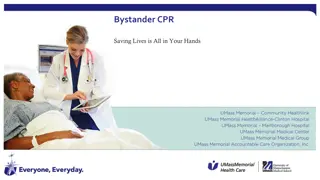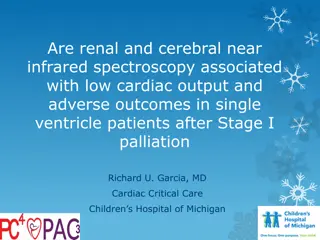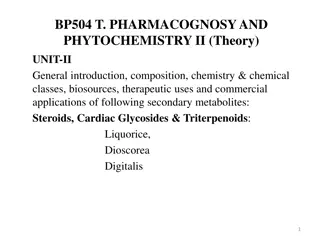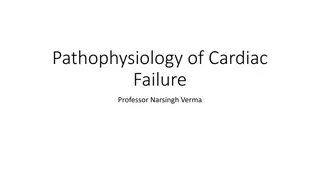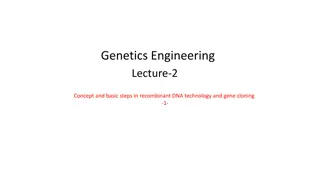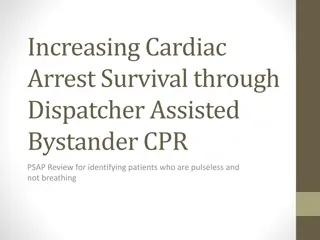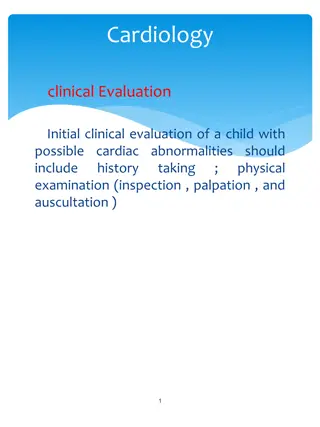Artificial Cardiac Pacemakers
Arrhythmia is a heart condition that disrupts the regular rhythm of the heart, necessitating the use of artificial cardiac pacemakers to stabilize heart rates. Learn about the clinical need, historical development, types of devices, ethical considerations, regulatory bodies, working principles, and more in this informative presentation.
Uploaded on Feb 25, 2025 | 0 Views
Download Presentation

Please find below an Image/Link to download the presentation.
The content on the website is provided AS IS for your information and personal use only. It may not be sold, licensed, or shared on other websites without obtaining consent from the author.If you encounter any issues during the download, it is possible that the publisher has removed the file from their server.
You are allowed to download the files provided on this website for personal or commercial use, subject to the condition that they are used lawfully. All files are the property of their respective owners.
The content on the website is provided AS IS for your information and personal use only. It may not be sold, licensed, or shared on other websites without obtaining consent from the author.
E N D
Presentation Transcript
ARTIFICIAL CARDIAC PACEMAKERS BY ODAFEJIROROSUA IROROGHENE WILLIAM 15/ENG04/038 1
OUTLINE INTRODUCTION CLINICAL NEED HISTORICAL DEVELOPMENT TYPES MANUFACTURED DEVICES ETHICS STANDARDS REGULATORY BODIES WORKING PRINCIPLE CONCLUSION REFERENCES 2
INTRODUCTION Arrhythmia is a heart condition whereby the heart is unable to beat at a regular rhythmic pattern; sometimes too slow and sometimes too fast. Since the heart is the powerhouse of the body, it would be risky to not do anything about a faulty heart. Hence, measures have been put in place in order to manage this condition and allow the patient continue their normal lifestyle. A pacemaker is therefore needed since the SA node (natural pacemaker) is no longer working. 3
INTRODUCTION contd The pacemaker is a medical device that is used to stabilize the rate at which the heart beats whenever it becomes irregular (i.e. too fast or too slow). This pacemaker that is being presented is called an Artificial Cardiac Pacemaker because there is a natural pacemaker present in the human heart known as the SA node which is responsible for sending electrical impulses which causes contraction and allows blood to be pumped from the atrium to the ventricle. There are basically two types of Artificial Cardiac Pacemakers; the external and the internal which is otherwise referred to as Implantable Cardiac Pacemaker which is the focus of this preentation. 4
CLINICAL NEED According to World Health Organization (WHO), 30% of deaths around the world are caused by Cardiovascular diseases. Most of them could have been prevented by pacing the heart to correct heart rate. The application of Artificial Cardiac Pacemakers can be found in the Heart and specifically in correcting heart rates. It is used in Third degree AV blocks to normalize the patient s heart rate, increase the low blood pressure and stabilize the blood dynamics. 5
CLINICALNEED Although, it can also be used in second degree AV block but the Third Degree AV is a more critical condition since the nerve impulse generated at the SA node in the Atrium cannot propagate to the Ventricles, thus the need for a pacing device. 6
HISTORICAL DEVELOPMENT It was invented by John Alexander Hopps, a Canadian Electrical Engineer a year after he successfully restarted the heart of a dog with his first invention; the cardiac defibrillation machine although, it was too large to be used internally. In 1958, Rune Elmqvist., an American Electrical Engineer developed the first Implantable Artificial Cardiac Pacemaker but it only lasted for two days but in 1960, Wilson Greatbatch developed it into a longer lasting device with lithium batteries. 7
HISTORICAL DEVELOPMENT contd The implantable pacemaker was only capable of pacing the Ventricle (Lower chamber) and it was a Single Chamber Pacemaker but this created a need for the one that could pace both the Atrium (Upper Chamber) and the Ventricle (Lower Chamber). In 1962, the Double Chamber (Dual Chamber) pacemaker solved the problem of the single chamber but it had the challenge of not being able to pace the heart rate with response to the activity being undertaken by the patient; it produced a fixed heart rate. 8
HISTORICAL DEVELOPMENT contd The problem discovered from the usage of the Double Chamber Pacemaker was solved by the Rate-Responsive Pacemaker by using a piezoelectric crystal that bends according to body activity and sends an electrical signal that allows the pacemaker pace according to the activity. Modern Rate-Responsive Pacemakers have replaced the piezoelectric crystal with an accelerometer for more accurate pacing. By default, the pacemakers pace only one ventricle but sometimes, the heart s function is so decreased that both ventricles must be paced which led to the development of a Bi-ventricular Pacemaker. 9
TYPES There are basically three types of pacemakers Single Chamber Pacemaker. Double Chamber Pacemaker. Rate-Responsive Pacemaker. Biventricular Pacemaker. 10
TYPES contd SINGLE CHAMBER PACEMAKER This type of pacemaker has one lead that connects the pulse generator to the right ventricle. It basically controls heartbeat pace. 11
TYPES contd DOUBLE CHAMBER PACEMAKER This pacemaker has two leads that connects to both chambers on the right side of the heart. It is programmed to allow both chambers work in harmony with each other. 12
TYPES contd RATE-RESPONSIVE PACEMAKER This pacemaker has a pulse generator that is capable of sensing changes in body activity and breathing rate in order to allow the pacemaker reduce or increase the heart rate accordingly. 13
TYPES contd BIVENTRICULAR PACEMAKER This pacemaker is also known as a cardiac resynchronization therapy (CRT) device, has three leads connected to the right atrium and both ventricles. It is used to treat people with arrhythmias. Patients suffering from arrhythmias have a problem with both ventricles working in harmony that is why this type of pacemaker is existing. 14
MANUFACTURED DEVICES There are basically three main manufacturers, they are; Medtronic Abbot Laboratories Boston Scientific 15
MANUFACTURED DEVICES MEDTRONICS Medtronics is one of the top pacemaker manufacturing companies and they have manufactured at total of eleven pacemaker models at the time of preparing this presentation. They include; 16
MANUFACTURED DEVICES MEDTRONICS 1. Micra Transcatheter Pacing Systems: According to their website, it is self-contained in the heart, it does not require a lead, it leaves no chest scar and no bump under the skin. They have model numbers MC1AVR1 and MC1VR01. FIG. 1: MICRA by Medtronics 17
MANUFACTURED DEVICES MEDTRONICS 2. Azure: According to their website, it is equipped with BlueSync technology and is compatible with MyCareLink Heart mobile app for remote monitoring. It is wirelessly and securely tranfers heart device information to the clinic. They have model numbers W1DR01, W1SR01, W3DR01, W3SR01. FIG. 2: Azure by Medtronics 18
MANUFACTURED DEVICES MEDTRONICS 3. Azure MRI: It has the same features as the Azure but is capable of operating in MRI environments when specific conditions are met. They have model numbers A2DR01, A3SR01. FIG. 3: Azure MRI by Medtronics 19
MANUFACTURED DEVICES MEDTRONICS 4. Adapta: According to their website, it waits for the heartbeat of the patient before it paces to avoid unnecessary pacing and they are completely automatic, constantly adjusting settings to meet patients need. They have model numbers ADDR01, ADDR03, ADDR06, ADDRL1, ADDRS2. FIG. 4: Adapta by Medtronics 20
MANUFACTURED DEVICES MEDTRONICS 5. Revo MRI 6. Sensia 7. Versa 8. EnRhythm 9. Sigma 10.Kappa SureScan . . . . . 400. 21
MANUFACTURED DEVICES The other manufacturers have similar products with similar features, hence there is no unique feature that makes any manufacturer different. It is only a matter of choice or cost. 22
ETHICS Patient privacy and confidentiality of information is paramount and all existing remotely-transferrable patient information pacemakers ensure that the patients information is securely transmitted to the hospital, cyber security is taken into consideration. Both the doctor and the patient can decide to take off the pacemaker for reasons of futility or autonomy. 23
STANDARDS EN 50061: Safety of Implantable Cardiac Pacemakers. ISO 5841-1:1989: Cardiac pacemakers Part 1: Implantable pacemakers. 24
REGULATORY BODIES UNITED KINGDOM (UK): Medicines and Healthcare products Regulatory Agency (MHRA). UNITED STATES OF AMERICA (USA): Food and Drug Administration (FDA). NIGERIA: NationalAgency for Food and Drug Administration and Control (NAFDAC). 25
WORKING PRINCIPLE There are different types of pacemakers but the most prominently used is the dual chamber pacemaker. It requires two pacing leads; both place on the right hand side of both chambers. It monitors electrical activity in the atrium and/or the ventricle to see if pacing is needed and when needed, the pulses are timed to mimic the way the heart pumps naturally. 26
WORKING PRINCIPLE It comprises primarily of three parts: Electrical pulse generator. Power source (battery). Electrode (lead) system. The electrical pulse generator consists of the following components: Sense amplifier circuit. Timing control circuit. Output driver circuit. 27
WORKING PRINCIPLE contd The electrodes measure the electrical activity of the heart, amplifies the signal and compares the signals received to the reference voltage. If the signal received is the same as that of the reference voltage, then the heart is normal and no signals are sent but if it is low or high, then the pulse generator starts sending signals till the heart s activity returns to normal. A timing control is needed to control the time difference between the pulses to the SA node and AV node which is 0.2 sec. 28
WORKING PRINCIPLE contd FIG. 5: THE BLOCK DIAGRAM OF A PACEMAKER
WORKING PRINCIPLE contd FIG. 6: DIAGRAM OF AN IMPLANTABLE ARTIFICIAL CARDIAC PACEMAKER (Credit: Steven Fruitsmaak) 30
CONCLUSION A lot of advancements have been made in pacemakers technology. Most manufacturers now include IoT to enable the patient monitor the pacemaker from a mobile application and transmit data securely and wirelessly to the clinic in any critical situation. One of the researches that is worthy of mention is the elimination of leads in the pacemakers, thus leadless pacemakers. At the time at which this presentation was prepared, it was still being developed with only the single chamber leadless pacemaker already available which would not be helpful for all cases of Arrhythmia. 31
REFERENCES Arrhythmia | Irregular heartbeat | MedlinePlus. (n.d.). MedlinePlus - Health Information from the National Library of Medicine. https://medlineplus.gov/arrhythmia.html Pacemakers and defibrillators save lives in different ways. (2019, December 10). Health Essentials from Cleveland Clinic. https://health.clevelandclinic.org/pacemakers-defibrillators-save-lives-in- different-ways-video/ ECG learning center. (n.d.). ECG Learning Center - An introduction to clinical electrocardiography. https://ecg.utah.edu/lesson/6#Complete Heart block. (2017, October 23). nhs.uk. https://www.nhs.uk/Conditions/Heart- block/Pages/Introduction.aspx Development of the cardiac pacemaker. (n.d.). ari.info. https://www.animalresearch.info/en/medical-advances/timeline/cardiac-pacemakers/ Hopps, John A. (1981-01-01). "The Development of the Pacemaker". Pacing and Clinical Electrophysiology. 4 (1): 106 108. doi:10.1111/j.1540-8159.1981.tb03682.x. ISSN 1540-8159. Pacemaker history and development - Inova heart & vascular institute northern Virginia - Inova. (n.d.). World-class heart and vascular care for Northern Virginia and Washington, DC metro area - Inova. https://www.inovaheart.org/heart-care/pacemaker/history 32
REFERENCES Inventor of pacemaker dies at 92. (2011, September 30). BBC News. https://www.bbc.com/news/world-us- canada-15085056 Types. (n.d.). Stanford Health Care (SHC) - Stanford Medical Center | Stanford Health Care. https://stanfordhealthcare.org/medical-treatments/p/pacemaker/types.html Medtronic. (n.d.). Medtronic pacemakers. Medical Technology, Services, and Solutions Global Leader | Medtronic. https://www.medtronic.com/us-en/patients/treatments-therapies/pacemakers/our.html What are the different types of pacemakers? (n.d.). WebMD. https://www.webmd.com/heart-disease/qa/what- are-the-different-types-of-pacemakers Pacemakers. (n.d.). National Heart, Lung, and Blood Institute (NHLBI). https://www.nhlbi.nih.gov/health- topics/pacemakers How a pacemaker works. (2019, October 15). Durofy. https://durofy.com/how-a-pacemaker-works The ethics of implantable devices. (2007, October 1). ResearchGate. https://www.researchgate.net/publication/6078171_The_ethics_of_implantable Simulation of an artificial cardiac pacemaker * BENG 122 a : Biosystem and controls. (n.d.). Semantic Scholar | AI-Powered Research Tool. https://www.semanticscholar.org/paper/Simulation-of-an-Artificial- Cardiac-Pacemaker-*-122-Ong-Nacinopa/f9622d1060fddfc5b385d9dc06a1f7c5ba0c9b13/figure/18 33
